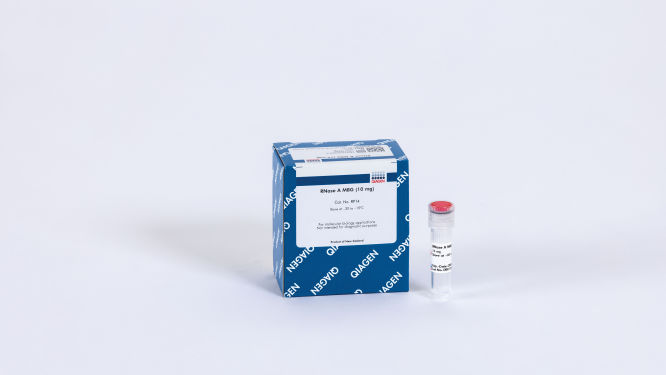Cat. No. / ID: RP14
Features
- Possesses enzyme activity of >80 units/mg protein
- Degrades RNA to cyclic nucleotide monophosphates to 5’-OH and 2’-, 3’-cyclic monophosphate
- No endonuclease or exonuclease activity towards DNA substrates
- Selectively cleaves single-stranded RNA 3’ next to pyrimidine residues
Product Details
The Ribonuclease A (RNase A) is a 13.7 kDa (monomer) endoribonuclease isolated from bovine pancreas, which selectively cleaves single-stranded RNA 3’ next to pyrimidine residues (cytosine, uracil). It degrades RNA to cyclic nucleotide monophosphates to 5’- OH and 2’-, 3’-cyclic monophosphate. The enzyme exhibits no endonuclease or exonuclease activity toward DNA substrates. RNase A removes RNA during the isolation procedures of plasmid and genomic DNA.
It is supplied with 1–10 mg/mL by resuspending in 10 mM Tris-HCl (pH 7.5), 15 mM NaCl, 50% (v/v) glycerol or in TE buffer.
One unit of activity is defined as the amount of enzyme which causes the hydrolysis of RNA to yield a velocity constant, k=1, at 25°C and pH 5.0.
Performance
| Assay | Specification |
| Activity | 94.5 U/mg (Kunitz) |
| DNase contamination | None detected |
| Protease contamination | None detected |
Principle
RNase A is very active under a wide range of reaction conditions and is difficult to inactivate. At low salt concentrations (up to 100 mM NaCl), the RNase A cleaves single- and double-stranded RNA as well as an RNA strand in RNA-DNA hybrids. However, under high salt concentrations (>300 mM NaCl), RNase A specifically cleaves single-stranded RNA.
RNase A cleaves specifically at the 3′-side of pyrimidine (uracil or cytosine) phosphate bonds. Ribonucleases do not hydrolyze DNA because the DNA lacks 2′-OH groups essential for forming cyclic intermediates. The enzyme is active under a wide range of reaction conditions. At low salt concentrations (0 to 100 mM NaCl), RNase A cleaves single-stranded and double-stranded RNA as well the RNA strand in RNA-DNA hybrids. However, at NaCl concentrations of 0.3 M or higher, RNase A specifically cleaves single-stranded RNA. RNase is supplied as a lyophilized powder.
Procedure
Usage
Stock solutions should be prepared to a final concentration of 1–10 mg/mL by resuspending in 10 mM Tris-HCl (pH 7.5), 15 mM NaCl, 50% (v/v) glycerol or in TE buffer.
The recommended working solution concentration depends on the application.
- For removal of RNA from plasmid preparations, use 10 μg/mL working solution and incubate the sample for 1 hour at room temperature.
- For the preparation of „blunt ends” of double-stranded cDNA, use a 100 ng/mL working solution.
Applications
This is used for applications such as:
- Purification of RNA-free DNA
- Isolation of plasmid and genomic DNA
- Removal of RNA during recombinant protein preparations
- Protection of RNA during assays
- Mapping of single-based mutations in DNA or RNA

